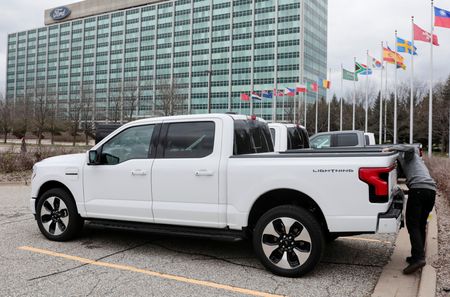By David Shepardson
WASHINGTON (Reuters) -U.S. National Transportation Safety Board Chair Jennifer Homendy on Wednesday raised concerns about the increased risk of severe injury and death from heavier electric vehicles on U.S. roads.
She cited a General Motors GMC Hummer EV that weighs over 9,000 pounds, up from about 6,000 pounds for the gasoline version, and the Ford F-150 Lightning EV, which is between 2,000 and 3,000 pounds heavier than the non-electric version.
The heavier weight “has a significant impact on safety for all road users,” she said Wednesday in a speech. “We have to be careful that we aren’t also creating unintended consequences: more death on our roads.”
GM said “safety is at the cornerstone at everything we do. All GM vehicles are engineered to meet or exceed all applicable motor vehicle safety standards.” Ford did not immediately comment.
Homendy’s comments come as the U.S. has seen a sharp rise in traffic deaths since the start of the COVID-19 pandemic and U.S. vehicles get keep getting larger on average.
The Environmental Protection Agency said last month average new vehicle weight and horsepower both hit new records in 2021 with average vehicle weight hitting 4,289 pounds in 2021 as SUV and truck sales rise and both are forecast to hit new records in 2022.
U.S. traffic deaths jumped 10.5% in 2021 to 42,915, the largest number killed on American roads in a year since 2005, after rising 7% in 2020, and declined slightly in the first nine months of 2022 but remain high.
Acting NHTSA Administrator Ann Carlson told reporters Monday that the agency was studying the impact of vehicle size on roadway safety. Carlson said the agency was “very concerned” about the “degree to which heavier vehicles contribute to greater fatality rates.”
She noted that some subscribe to the “mantra that bigger is safer” but that did not necessarily take into account other factors.
“Bigger is safer if you don’t look at the communities surrounding you and you don’t look at the other vehicles on the road,” Carlson said. “It actually turns out to be a very complex interaction.”
(Reporting by David Shepardson; Editing by Leslie Adler and Christopher Cushing)

